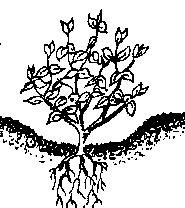Hardy Fuchsias.
Jaspers Hardy Queen
The idea came into being in 1985.
Anton Bremer came up with the idea to give visitors of the spring meeting a survey form to write down their experiences which fuchsias were hardy in their garden, 1/3 of the forms were filled in and it became clear that
F. magelanica, F. regia and F. procumbens are hardy.
The Extensive Technical Commission, UTC, then wanted a test field to test fuchsias for winter hardiness, preferably in the east of the country.
In 1986, the trial field was started at Kwekerij Overhagen in Velp, under the supervision of Gerrit van Veen.
A hundred plants were planted then, 3 per species. In the first test year there were about 60 species. At the end there were about 300 species.
Mr. Buurman of the Nursery came up with the idea to continue at another place of the nursery, his tractor was disinfected and an asparagus field was plowed, this became the second test field.
As a precaution, all the plants were put in holes of 40 x 40 x 40 cm, filled with potting soil. Also, all old plants that did not show any disease were excavated and rinsed out, this was a success, only one plant was killed at the time, at the time only two plants were planted per species.
Deepened planting
Jaspers Hardy Red Pipes
Standards and properties.
In the time of the experimental garden there were two standard winters, 1986-1987, with 37 frost days and 26 ice days, the lowest temperature was -21 degrees, but there was a snow cover. And 1990-1991, with 41 frost days and 11 ice days the lowest temperature was -18 degrees, but no snow cover.
In the beginning, the plants were covered with beech leaves but this was blowing away. No cover was used in later years.
It has also been established that plants that died were more likely to suffer from wet foot, root rot, than from frost.
Planting and care
The type of soil at the Overhagen nursery is a mixture of sand and clay, supplemented with potting soil, which later proved to be the ideal soil type. Sandy soil supplemented with potting soil is also good. But clay soil is a different story, the first year the plants do well, but then the clay starts to sound, there is no more air at the roots and the plants, these rot away by too much moisture and the plants die off .
What also emerged is that the plants do the best in full sun, Is this not possible then at least morning sun, plants in the shade go dead or bloom very late, this has to do with warming of the ground in the spring especially the foot of the plant.
Use plants that are at least 12 months old, plant them in preferably half to the end of May, but later is also possible until the end of August.
Plant the plants deeper as normal plants, preferably in a dimple of 5 to 10 cm deep and 30 cm around, make sure that this well at the end of the year is filled with soil, the intention is that the plants end up on the branch parts that are then under the ground. Tops is not necessary.
Jaspers Hardy Dream
Fertilization
Be careful with fattening, the plants grow better in the soil as in pots and fattening is only necessary if the leaf becomes lighter in color and the growth decreases, otherwise you will get plants that grow and flower badly. It has also been shown that diseases occur less frequently, presumably because there are more minerals in the soil than with potting soil.
Bloom
What emerged from the trial is that the plants bloom earlier in pots, but also longer.
The flowering starts at a reasonable to good spring already at the end of May when the frost is not too bad, under the -3 degrees they are still in bloom in November.
What emerged from the trial is that the plants bloom earlier in pots, but also longer.
Achievement
Jaspers Hardy King
Prune
Never prune in the autumn or winter, prune until late March in early April, the branches are windbreakers and help the plant through the winter.
Even if there was no winter, it is advisable to prune the plants at the end of March in early April to 10 cm from the ground, especially the large species, the other ugly plants, small species such as Tom Thumb and Lady Thumb may be less to be pruned. In any case, cut away the dead branches.
Winter hard Species
At nursery Van der Velde there is a show garden and they have an assortment of about 90 species.
At the Zeelenberg nursery, hardy fuchsias are also available.
The group from that time has defined a personal top ten, and the following species are shown to be the best.
Also all F. magellanica species are hardy.
Achievement
Annabel
Beacon
Beacon Rosa
Bernisser Hardy
Cliff’s Hardy
Cloverdale Pearl
Corallina
Display
F. magellanica tricolori
F. regia (Gerrit)
Flash
Flocon de Neige
Genii
Gerrit van Veen
Graf Witte
Isis
Jaspers Kameleon
Komeet
Lady Thumb
Lena
Lidie Bartelink
Lotty Hobby
Mephisto
Papoose
Rose of Castille Improved
Saturnus
Suzanne
Tom Thumb
Whiteknights Pearl
Conclusion
Advantages: easy, no dragging with plants, early and long flowering, no winter storage needed, little to
no watering, little manure needed.
Disadvantages: no crown trees and hangers.
Photos: Hans van Aspert.
Author: Hans van Aspert.
